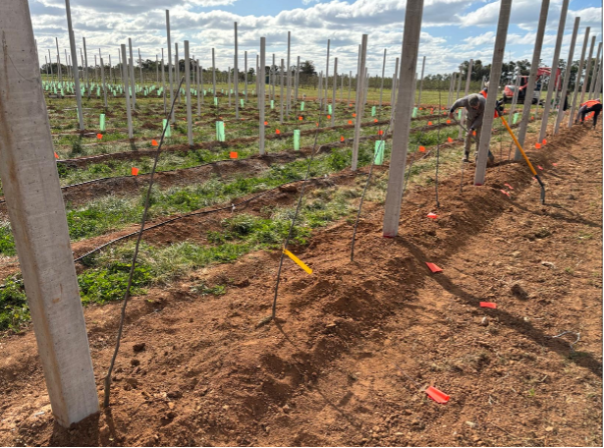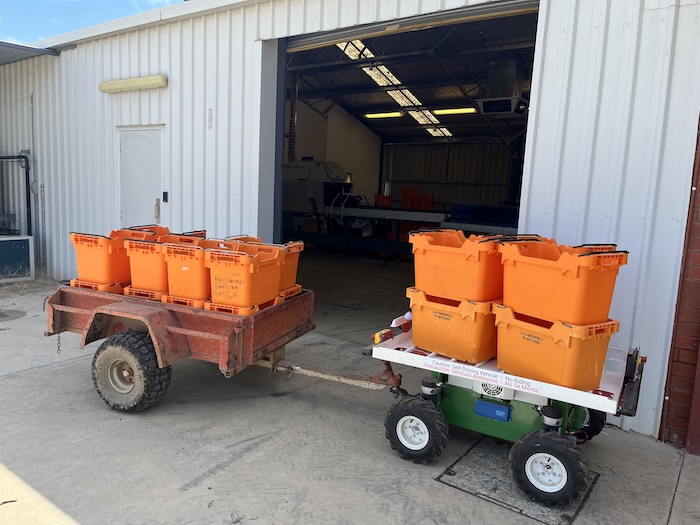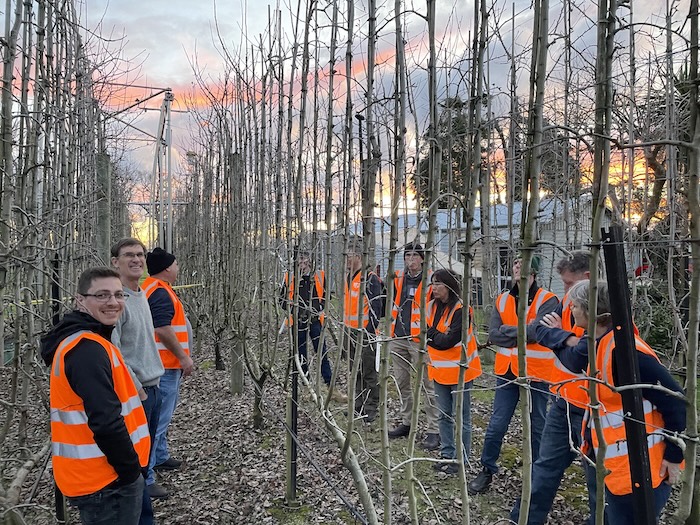Narrow orchard systems
Researching orchard design for fruit profitability
Researchers at Agriculture Victoria’s Tatura SmartFarm are investigating if fruit yield and quality can be increased by designing orchards differently.
A Narrow Orchard Systems (NOS) experiment is being established to determine the extent of benefits that a narrow design can achieve.

Benefits of NOS
NOS are an innovative approach to orchard design associated with benefits such as increased yield and improved fruit quality, plus, efficiencies with water, labour and energy costs.
At Tatura SmartFarm, the research team are experimenting with NOS design features such as row spacing, orientation, canopy height and width to create beneficial fruit growing conditions.
NOS design creates a spacious light environment within the tree canopy. This research will help with understanding the impact light has on fruit colour development and bleaching, fruit sunburn, leaf photosynthesis, flower initiation and yield.
The NOS experiment will also allow a study of the additional benefits of managing a fruit orchard that is smaller in height making it easier to prune and thin fruit without the need for ladders.
Orchard height also provides greater opportunity for mechanical harvesting and that can improve occupational, health and safety risks associated with manual labour.
Additionally, the research will investigate the adaptive response of trees grown in a NOS to changing climate conditions.
Using AgTech in NOS
Central to NOS research is the use of AgTech for managing the orchard as well as capturing data.
- The Cartographer removes the need for manual measurements as the electric all-terrain vehicle uses a combination of cameras, a scanner, strobe lighting and GPS. A wide range of data is collected such as fruit size, fruit number, fruit colour, tree shape, tree size and in addition, the Cartographer can also estimate light interception by each tree. Find more information about how the Cartographer is used in the NOS.
- Light Detection and Ranging (LiDAR) scanning technology will be used to create a digital twin of the orchard. By digitising the orchard, Agriculture Victoria will be able to overlay various models and test the impact of NOS on light distribution through the tree canopy. This type of technology will be explored for measuring fruit quality, the position of fruit in the canopy, how light impacts its quality and tree responses under different climate conditions.
Additional AgTech under evaluation in the NOS experiment includes:
- autonomous bin pickups
- variable rate spray technology
- automated retractable netting
- spatial monitoring of yield and fruit quality
- internet-based wireless sensors for irrigation and fruit tracking
- string flower thinners
- pneumatic defoliators and hedgers.

Designing a NOS
NOS has been implemented at Tatura SmartFarm using 2 different design approaches:
Design 1
- Features trees growing in rows spaced 2 metres apart (management practice is currently 3 to 3.5 m).
- Five species (nectarine, plum, cherry, apple and pear) each on three different rootstocks and grown to a height of 2 m and 3.5 m will be compared.
- Emphasis is on ensuring the canopy is thin enough (a width of 20 cm) to create a canopy with gaps that provide good light distribution across adjoining rows of trees.
- In the first year of tree establishment, a base of two cordons will be laid to provide a supporting shape for the vertical leaders.
- Vertical leaders will be spaced at 20 cm to 50 cm apart depending on the species.
Design 2
- A demonstration pedestrian apple block is also being established that features trees growing in rows spaced 2 m apart with trees spaced at 2 m along each row and tree height will be kept to 2 m.
- Vertical leaders will be spaced 25 cm apart with eight leaders in total per tree.
- The canopy width will be maintained at 20 cm.
- The block will be used to test the suitability of various AgTech in NOS.

Implementing NOS in Victoria
NOS are more than the agronomy of growing trees. In the establishment phase they require planning, management and maintenance.
In addition, having sufficient small equipment is vital for efficiency and productivity.
Research findings can help inform commercial orchards with an interest in NOS.
The Narrow Orchard Systems for Future Climates project is funded by the Hort Frontiers Advanced Production Systems Fund, part of the Hort Frontiers strategic partnership initiative developed by Hort Innovation. The project is a partnership between state agriculture agencies in Victoria, South Australia, Western Australia and New South Wales, the University of Queensland, and Plant and Food Research New Zealand.
For more information about NOS research at Tatura SmartFarm contact ian.goodwin@agriculture.vic.gov.au